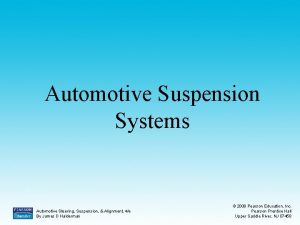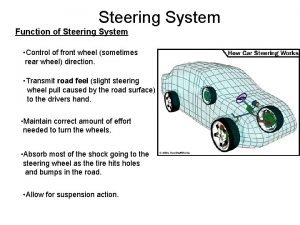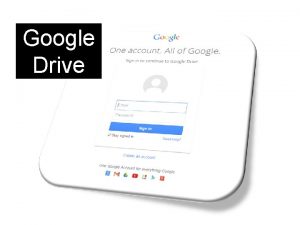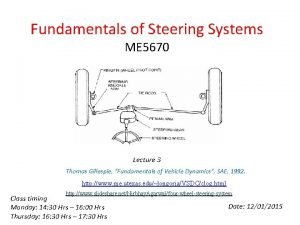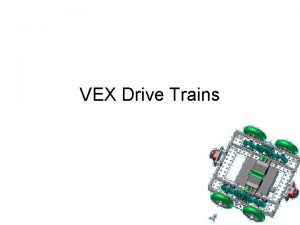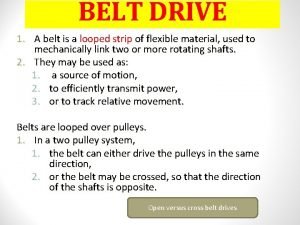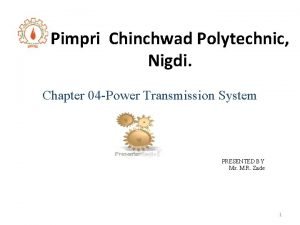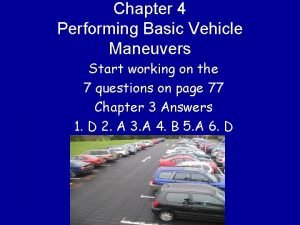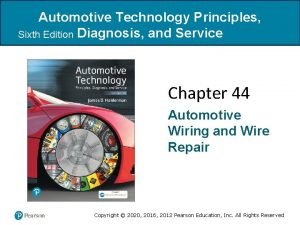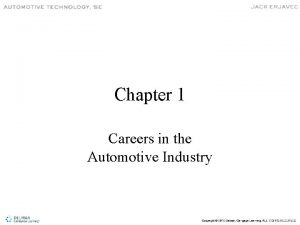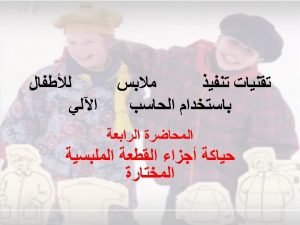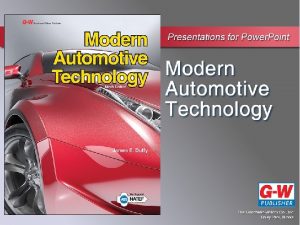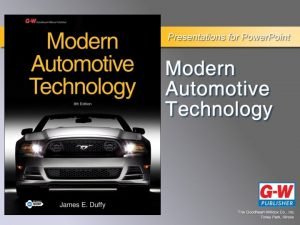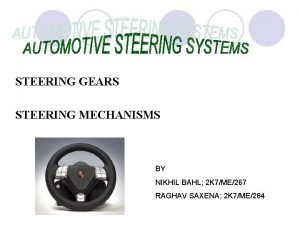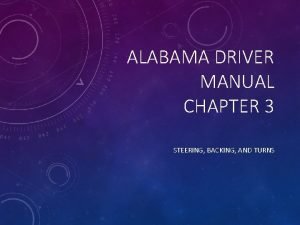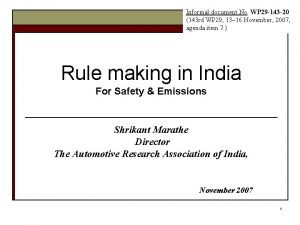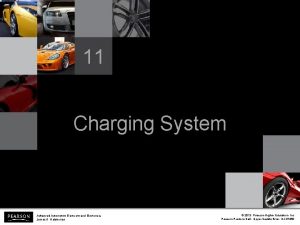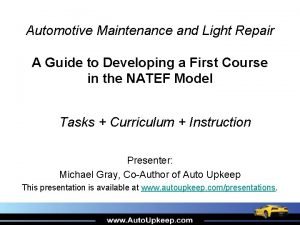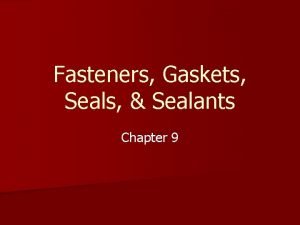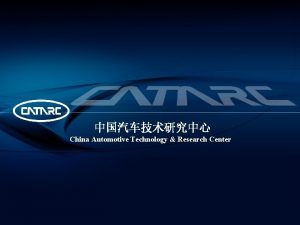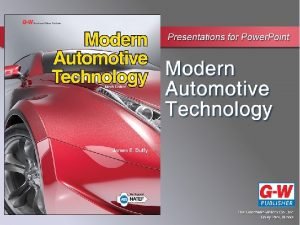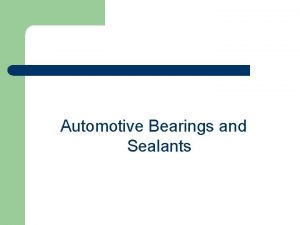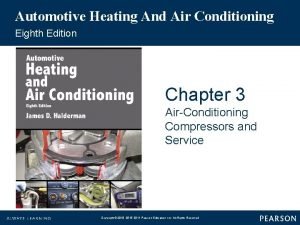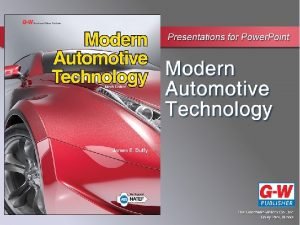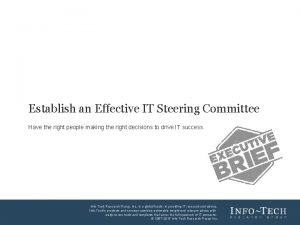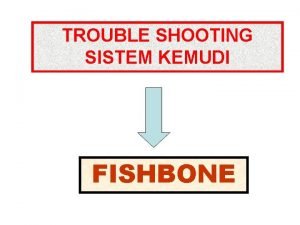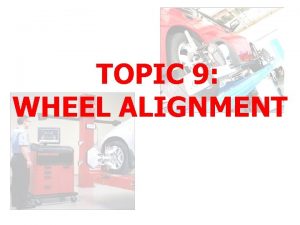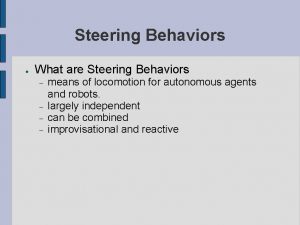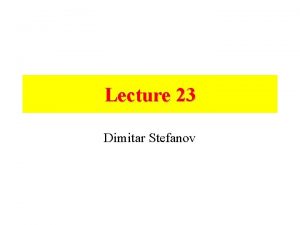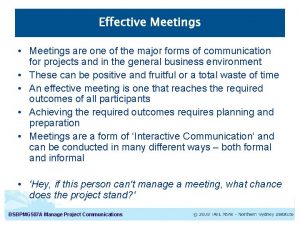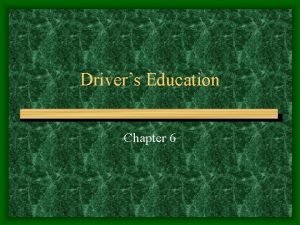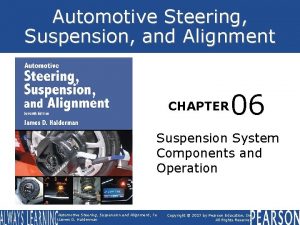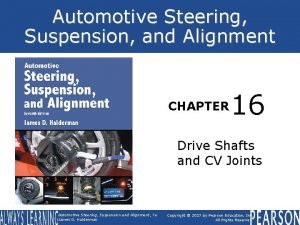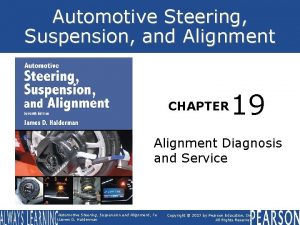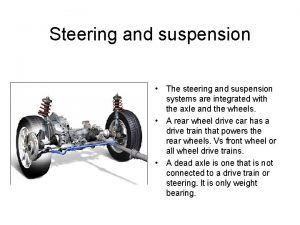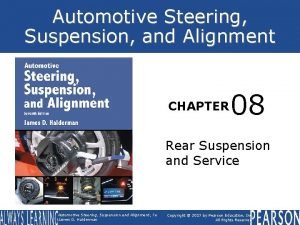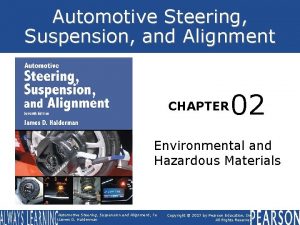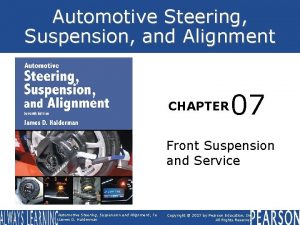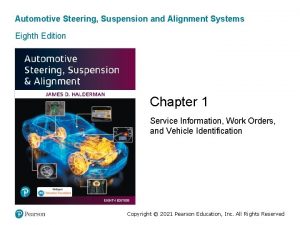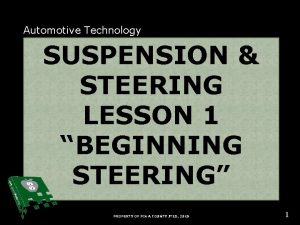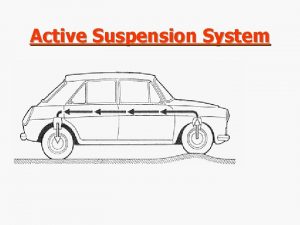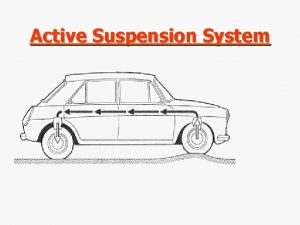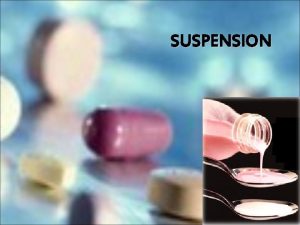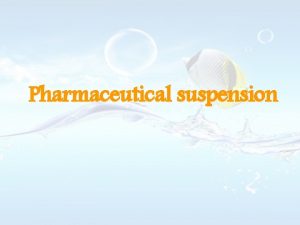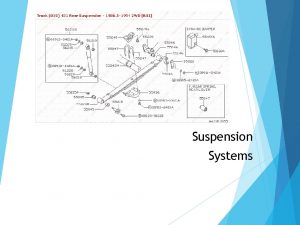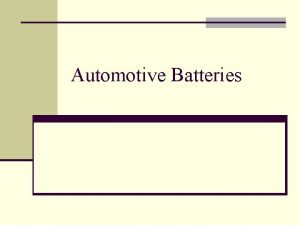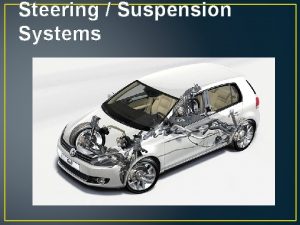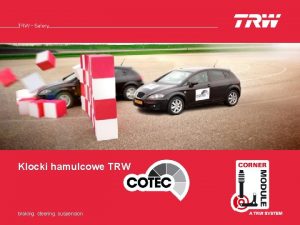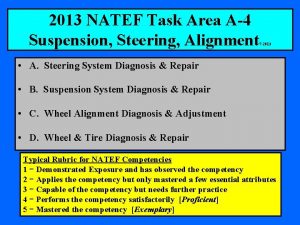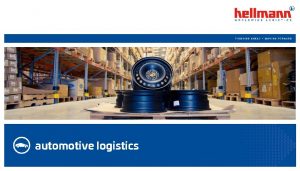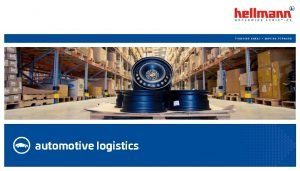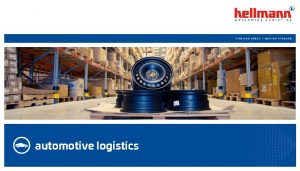Automotive Steering Suspension and Alignment CHAPTER 17 Drive











































- Slides: 43

Automotive Steering, Suspension, and Alignment CHAPTER 17 Drive Shaft and CV Joint Service Automotive Steering, Suspension and Alignment, 7 e James D. Halderman Copyright © 2017 by Pearson Education, Inc. All Rights Reserved

FIGURE 17. 1 Notice how the needle bearings have worn grooves, called Brinelling, into the bearing surface of the U-joint. Automotive Steering, Suspension and Alignment, 7 e James D. Halderman Copyright © 2017 by Pearson Education, Inc. All Rights Reserved

FIGURE 17. 2 All U-joints and spline collars equipped with a grease fitting should be greased four times a year as part of a regular lubrication service. Automotive Steering, Suspension and Alignment, 7 e James D. Halderman Copyright © 2017 by Pearson Education, Inc. All Rights Reserved

FIGURE 17. 3 Many U-joints require a special grease gun tool to reach the grease fittings. Automotive Steering, Suspension and Alignment, 7 e James D. Halderman Copyright © 2017 by Pearson Education, Inc. All Rights Reserved

FIGURE 17. 4 Always mark the original location of U-joints before disassembly. Automotive Steering, Suspension and Alignment, 7 e James D. Halderman Copyright © 2017 by Pearson Education, Inc. All Rights Reserved

FIGURE 17. 5 Two types of retaining methods that are commonly used at the rear U-joint at the differential. Automotive Steering, Suspension and Alignment, 7 e James D. Halderman Copyright © 2017 by Pearson Education, Inc. All Rights Reserved

FIGURE 17. 6 The best way to check any U-joint is to remove the driveshaft from the vehicle and move each joint in all directions. A good U-joint should be free to move without binding. Automotive Steering, Suspension and Alignment, 7 e James D. Halderman Copyright © 2017 by Pearson Education, Inc. All Rights Reserved

FIGURE 17. 7 Typical U-joint that uses an outside snap ring. This style of joint bolts directly to the companion flange that is attached to the pinion gear in the differential. Automotive Steering, Suspension and Alignment, 7 e James D. Halderman Copyright © 2017 by Pearson Education, Inc. All Rights Reserved

FIGURE 17. 8 A U-joint that is held together by nylon and usually requires that heat be applied to remove from the yoke. Automotive Steering, Suspension and Alignment, 7 e James D. Halderman Copyright © 2017 by Pearson Education, Inc. All Rights Reserved

FIGURE 17. 9 Use a vise and two sockets to replace a U-joint. One socket fits over the bearing cup and the other fits on the bearing to press-fit the cups from the crosspiece. Automotive Steering, Suspension and Alignment, 7 e James D. Halderman Copyright © 2017 by Pearson Education, Inc. All Rights Reserved

FIGURE 17. 10 Taping the U-joint to prevent the caps from coming off. Automotive Steering, Suspension and Alignment, 7 e James D. Halderman Copyright © 2017 by Pearson Education, Inc. All Rights Reserved

FIGURE 17. 11 A special tool being used to press apart a U-joint that is retained by injected plastic. Heat from a propane torch may be necessary to soften the plastic to avoid exerting too much force on the U-joint. Automotive Steering, Suspension and Alignment, 7 e James D. Halderman Copyright © 2017 by Pearson Education, Inc. All Rights Reserved

FIGURE 17. 12 Removing the worn cross from the yoke. Automotive Steering, Suspension and Alignment, 7 e James D. Halderman Copyright © 2017 by Pearson Education, Inc. All Rights Reserved

FIGURE 17. 13 When installing a new U-joint, position the grease fitting on the inboard side (toward the driveshaft tube) and in alignment with the grease fitting of the U-joint at the other end. Automotive Steering, Suspension and Alignment, 7 e James D. Halderman Copyright © 2017 by Pearson Education, Inc. All Rights Reserved

FIGURE 17. 14 The working angle of most U-joints should be at least 1/2 degree (to permit the needle bearing to rotate in the U-joints) and should not exceed 3 degrees or a vibration can occur in the driveshaft, especially at higher speeds. Automotive Steering, Suspension and Alignment, 7 e James D. Halderman Copyright © 2017 by Pearson Education, Inc. All Rights Reserved

FIGURE 17. 15 An inclinometer with a magnetic base is being used to measure the angle of the driveshaft at the rear U-joint. Automotive Steering, Suspension and Alignment, 7 e James D. Halderman Copyright © 2017 by Pearson Education, Inc. All Rights Reserved

FIGURE 17. 16 Placing a tapered metal wedge between the rear leaf spring and the rear axle pedestal to correct rear U-joint working angles. Automotive Steering, Suspension and Alignment, 7 e James D. Halderman Copyright © 2017 by Pearson Education, Inc. All Rights Reserved

FIGURE 17. 17 A transmission oil pan gasket leak allowed automatic transmission fluid (ATF) to saturate the rear transmission mount rubber, causing it to collapse. Automotive Steering, Suspension and Alignment, 7 e James D. Halderman Copyright © 2017 by Pearson Education, Inc. All Rights Reserved

FIGURE 17. 18 The hub nut must be removed before the hub bearing assembly or drive axle shaft can be removed from the vehicle. Automotive Steering, Suspension and Alignment, 7 e James D. Halderman Copyright © 2017 by Pearson Education, Inc. All Rights Reserved

FIGURE 17. 19 Many knuckles are attached to the ball joint on the lower control arm by a pinch bolt. Automotive Steering, Suspension and Alignment, 7 e James D. Halderman Copyright © 2017 by Pearson Education, Inc. All Rights Reserved

FIGURE 17. 20 The preferred method for separating the tie rod end from the steering knuckle is to use a puller such as the one shown. Automotive Steering, Suspension and Alignment, 7 e James D. Halderman Copyright © 2017 by Pearson Education, Inc. All Rights Reserved

FIGURE 17. 21 Many drive axles are retained by prevailing torque nut that must not be reused. Automotive Steering, Suspension and Alignment, 7 e James D. Halderman Copyright © 2017 by Pearson Education, Inc. All Rights Reserved

FIGURE 17. 22 A special General Motors tool is being used to separate the drive axle shaft from the wheel hub bearing. Automotive Steering, Suspension and Alignment, 7 e James D. Halderman Copyright © 2017 by Pearson Education, Inc. All Rights Reserved

FIGURE 17. 23 Most inner CV joints can be separated from the transaxle with a prybar. Automotive Steering, Suspension and Alignment, 7 e James D. Halderman Copyright © 2017 by Pearson Education, Inc. All Rights Reserved

FIGURE 17. 24 When removing a drive axle shaft assembly, use care to avoid pulling the plunge joint apart. Automotive Steering, Suspension and Alignment, 7 e James D. Halderman Copyright © 2017 by Pearson Education, Inc. All Rights Reserved

FIGURE 17. 25 If other service work requires that just one end of the drive axle shaft be disconnected from the vehicle, be sure that the free end is supported to prevent damage to the protective boots or allow the joint to separate. Automotive Steering, Suspension and Alignment, 7 e James D. Halderman Copyright © 2017 by Pearson Education, Inc. All Rights Reserved

FIGURE 17. 26 With a scribe, mark the location of the boots before removal. The replacement boots must be in the same location. Automotive Steering, Suspension and Alignment, 7 e James D. Halderman Copyright © 2017 by Pearson Education, Inc. All Rights Reserved

FIGURE 17. 27 Most CV joints use a snap ring to retain the joint on the drive axle shaft. Automotive Steering, Suspension and Alignment, 7 e James D. Halderman Copyright © 2017 by Pearson Education, Inc. All Rights Reserved

FIGURE 17. 28 After releasing the snap ring, most CV joints can be tapped off the shaft using a brass or shot-filled plastic (dead-blow) hammer. Automotive Steering, Suspension and Alignment, 7 e James D. Halderman Copyright © 2017 by Pearson Education, Inc. All Rights Reserved

FIGURE 17. 29 Typical outer CV joint after removing the boot and the joint from the drive axle shaft. Automotive Steering, Suspension and Alignment, 7 e James D. Halderman Copyright © 2017 by Pearson Education, Inc. All Rights Reserved

FIGURE 17. 30 The cage of this Rzeppa-type CV joint is being carefully inspected before being reassembled. Automotive Steering, Suspension and Alignment, 7 e James D. Halderman Copyright © 2017 by Pearson Education, Inc. All Rights Reserved

FIGURE 17. 31 Be sure to use all of the grease supplied with the replacement joint or boot kit. Use only the grease supplied and do not use substitute grease. Automotive Steering, Suspension and Alignment, 7 e James D. Halderman Copyright © 2017 by Pearson Education, Inc. All Rights Reserved

FIGURE 17. 32 A punch being used to keep the rotor from rotating while torquing the axle shaft spindle nut. Automotive Steering, Suspension and Alignment, 7 e James D. Halderman Copyright © 2017 by Pearson Education, Inc. All Rights Reserved

FIGURE 17. 33 The engine had to be raised higher to get the new (noncollapsed) engine mount installed. Automotive Steering, Suspension and Alignment, 7 e James D. Halderman Copyright © 2017 by Pearson Education, Inc. All Rights Reserved

Tools needed to replace a drive axle shaft on a General Motors vehicle include a drift, sockets, plus a prybar bearing/axle shaft special tool. Automotive Steering, Suspension and Alignment, 7 e James D. Halderman Copyright © 2017 by Pearson Education, Inc. All Rights Reserved

The drive axle shaft retaining nut can be loosened with the tire on the ground, or use a drift inserted into the rotor cooling fins before removing the nut. Automotive Steering, Suspension and Alignment, 7 e James D. Halderman Copyright © 2017 by Pearson Education, Inc. All Rights Reserved

Using a special tool to push the drive axle splines from the bearing assembly. Automotive Steering, Suspension and Alignment, 7 e James D. Halderman Copyright © 2017 by Pearson Education, Inc. All Rights Reserved

Remove the disc brake caliper and support it out of the way. Then, remove the disc brake rotor. Automotive Steering, Suspension and Alignment, 7 e James D. Halderman Copyright © 2017 by Pearson Education, Inc. All Rights Reserved

To allow for the removal of the drive axle shaft, the strut is removed from the steering knuckle assembly. Automotive Steering, Suspension and Alignment, 7 e James D. Halderman Copyright © 2017 by Pearson Education, Inc. All Rights Reserved

A prybar is used to separate the inner drive axle shaft joint from the transaxle. Automotive Steering, Suspension and Alignment, 7 e James D. Halderman Copyright © 2017 by Pearson Education, Inc. All Rights Reserved

After the inner joint splines have been released from the transaxle, carefully remove the drive axle shaft assembly from the vehicle. Automotive Steering, Suspension and Alignment, 7 e James D. Halderman Copyright © 2017 by Pearson Education, Inc. All Rights Reserved

To install, reverse the disassembly procedure and be sure to install the washer under the retainer nut, and always use a new prevailing torque nut. Automotive Steering, Suspension and Alignment, 7 e James D. Halderman Copyright © 2017 by Pearson Education, Inc. All Rights Reserved

Reinstall the disc brake rotor and caliper and then torque the drive axle shaft retaining nut to factory specifications. Automotive Steering, Suspension and Alignment, 7 e James D. Halderman Copyright © 2017 by Pearson Education, Inc. All Rights Reserved
 4e alignment
4e alignment What is the function of steering system
What is the function of steering system Google drive
Google drive Https://slidetodoc.com/
Https://slidetodoc.com/ Googlehttps://drive.google.com/drive/my-drive
Googlehttps://drive.google.com/drive/my-drive Steering geometry error
Steering geometry error Global and local alignment
Global and local alignment Global alignment
Global alignment Dna substitution
Dna substitution Global alignment vs local alignment
Global alignment vs local alignment Global alignment vs local alignment
Global alignment vs local alignment Vex drivetrain
Vex drivetrain Disadvantages of suspension therapy in physiotherapy
Disadvantages of suspension therapy in physiotherapy Differentiate between belt drive and chain drive
Differentiate between belt drive and chain drive Difference between open belt drive and cross belt drive
Difference between open belt drive and cross belt drive Chapter 6 performing basic vehicle maneuvers answers
Chapter 6 performing basic vehicle maneuvers answers Chapter 44 automotive wiring and wire repair
Chapter 44 automotive wiring and wire repair Chapter 2 automotive careers and ase certification
Chapter 2 automotive careers and ase certification Https drive google com file d 0b8f5bmoit8kbmx
Https drive google com file d 0b8f5bmoit8kbmx Https drive google com
Https drive google com Comait
Comait Automotive technology chapter 51 answers
Automotive technology chapter 51 answers Modified macpherson strut
Modified macpherson strut Cam and peg steering gear
Cam and peg steering gear Push-pull method
Push-pull method Curriculum guide for driver education in virginia module 3
Curriculum guide for driver education in virginia module 3 Automotive regulations and standards
Automotive regulations and standards Automotive technology principles diagnosis and service
Automotive technology principles diagnosis and service Advanced automotive electricity and electronics
Advanced automotive electricity and electronics Automotive maintenance and light repair answer key
Automotive maintenance and light repair answer key Automotive fasteners gaskets and sealants
Automotive fasteners gaskets and sealants China automotive technology & research center
China automotive technology & research center Automotive fasteners gaskets and sealants
Automotive fasteners gaskets and sealants Anaerobic sealant definition
Anaerobic sealant definition Automotive heating and air conditioning 8th edition
Automotive heating and air conditioning 8th edition Define the phrase “leaf spring windup.”
Define the phrase “leaf spring windup.” It steering
It steering Penyebab gerak bebas roda kemudi berlebihan
Penyebab gerak bebas roda kemudi berlebihan Car thrust angle
Car thrust angle Steering behaviors
Steering behaviors Steering angle formula
Steering angle formula Trimble true tracker
Trimble true tracker Steering committee meeting agenda sample
Steering committee meeting agenda sample 1. to steer straight forward, look
1. to steer straight forward, look
